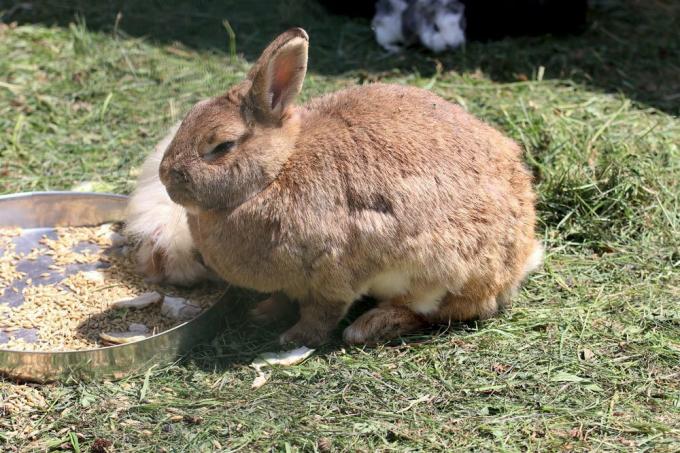
table of contents
- ingredients
- 1. Terpenes
- 2. Phorbol ester
- 3. 5-deoxyingenol
- 4. Oil that is not precisely defined
- Effect on people
- Effect on animals
- dogs
- Cats
- Rodents and rabbits
Croton is a popular ornamental plant that is kept mainly for its leaf color and variety of varieties. The miracle shrub comes from tropical Southeast Asia and northern Australia and must because of their Sensitivity to cold, 15 ° C is the minimum temperature, ideally kept indoors all year round will. Due to the proximity of the plant to humans and animals, many owners wonder whether Codiaeum variegatum, like many other tropical plants, is a poisonous plant.
ingredients
Yes, croton is poisonous, which is evident from its ingredients and membership of the milkweed family (. Euphorbiaceae), which is known for its poisonous species, particularly clearly shows. Like other taxa in the family, for example poinsettias (bot. Euphorbia pulcherrima) or wonder trees (bot. Ricinus communis), croton produces a white milky sap that is slightly toxic. In addition to the milky sap, the following parts of the plant are poisonous:
- bark
- leaves
- root
- blossoms
- Seeds

Compared to the rest of the plant, the flowers are less toxic and, in Europe, do not develop until old age. The following ingredients have been detected in Codiaeum variegatum and are responsible for their toxicity:
1. Terpenes
Terpenes are ingredients that are produced by many plants and that have a variety of functions. In the case of the croton plant, the terpenes are a protection against feeding that is extremely bitter and closes possible wounds caused by animals or humans. Two types of terpenes are produced by the plant:
- Diterpenester
- Triterpenester
The terpenes they contain are the most common cause of irritation in the milkweed family when they come into contact with the skin or mucous membranes of predators. At the same time, they act as a bitter substance, which is responsible for the inedibility of the croton. They consist of isoprene units, i.e. hydrocarbons. They are not only considered harmful to health, but also flammable.
2. Phorbol ester
These ingredients are considered to be particularly dangerous and can be found in numerous milkweed plants. As such, the substances are harmless alcohols within the diterpenes. However, their esters are highly toxic and also have an irritating effect on the skin and mucous membranes, only much more intensely. For example, they break down tissue and, in the long term, promote the development of cancer. Phorbol esters are not only found in Codiaeum variegatum and other plants, but also foods that you may consume more often, such as honey. But this is only the case if the plant is approached by bees, which is less common in Europe.
3. 5-deoxyingenol
The 5-Deoxyingenol or 5-Deoxyingenol 3-Angelat 20-Acetate is a toxin that occurs in all parts of the plants of croton and is part of ingenol mebutate. Ingenol mebutate is found, for example, in garden milkweed (bot. Euphorbia peplus) and is used in medicine to treat actinic keratosis. However, the substance itself is not nontoxic for humans and causes severe rashes, blistering and tissue damage. Furthermore, the substance is examined for possible carcinogenic properties.
4. Oil that is not precisely defined
There is also an oil in the plant that has not yet been adequately researched. However, it is known to be a carcinogen. Carcinogens are substances that have a cancer-promoting effect on the organism and mainly through the consumption of the plant parts, are not absorbed through external contact with the milky sap. In addition to being a carcinogen, the oil acts as a powerful laxative. For this purpose, certain quantities of the plant parts of the miracle shrub must also be consumed.
All of these ingredients together make for you toxic mixwhich has a particularly harmful effect on children and sensitive people. Furthermore, you should make sure that the milk sap produced by the crab flower is still in is kept in a white hue, but not as intense as in other taxa der Spurge family. Since this appears transparent at some times, you should therefore exercise caution when caring for the plant, as the milky sap is still there. The concentration of the ingredients does not depend on the age of the plant. That means, even young croton specimens are not to be underestimated.

tip: Do not confuse the miracle shrub with the croton oil tree (bot. Croton tiglium), which also belongs to the milkweed family. The toxicity of the croton oil tree is similar to that of the crab flower, but it is much stronger and can even increase the risk of cancer, especially skin cancer, in healthy people.
Effect on people
Humans are quickly endangered by poisoning by Codiaeum variegatum. Since the concentration of toxins in the croton plant is not exactly low, even small amounts lead to symptoms of poisoning. While an adult person does not suffer severe poisoning as quickly, children, the elderly and sensitive people should not go near Codiaeum variegatum or only under supervision. The following symptoms can appear:
- Irritation of the mucous membranes
- Irritation to the skin
- Tissue damage to mucous membranes and skin
- blow
- Eczema to the point of scarring
- diarrhea
- Vomit
- coma
- Coma less common and even death (children more severely affected)
So far, only a few known deaths from the plant are known. However, several children and some adults have died from consuming larger amounts, and no lethal dose is known. However, dealing with the plant itself is easy. Always wear when grooming, especially when pruning gloves and closed clothing. In addition, the croton plant should be placed in such a way that children cannot play under it and it is not easy to reach. You should also convey to your older children and people around the house that the miracle shrub is poisonous.
In the event of poisoning by the plant, you should pay attention to the following points:
- keep Calm
- Give fluids
- only tea or water
- alternatively give activated charcoal
- Observe the condition of the poisoned throughout the entire period
- pay particular attention to vital functions
- Call emergency number
- Poison Control Center to contact
As noted above, croton poisoning can quickly lead to coma. Therefore, quick action is required, especially if large quantities have been consumed and children are affected. This is the only way to avoid major damage.
Effect on animals
dogs
The croton plant is not only dangerous for humans. The best animal friend, the dog, should also let go of the plant. Since dogs generally respond poorly to any form of alcohol and many of the ingredients are based on alcohol, poisoning is often very severe and can be extremely stressful for the animal. Typical symptoms include:
- Vomit
- Diarrhea; bloody diarrhea possible
- Impaired consciousness
- Burning in the mouth, throat and throat
- Redness of the nose
- increased salivation
- Redness and irritation of the affected mucous membranes
- Coma to death
Reddening of the skin is not necessarily a problem for the four-legged friends, as their fur protects them from the milky sap. Therefore, you should exercise more caution if you have a furless dog, such as a Peruvian hairless dog or a Chinese crested dog. These can also easily injure themselves on the plants as soon as the skin comes into contact with the milky sap. Since the dog's skin is not significantly thicker, the milkweed family is just as poisonous. Adult dogs will often stop using the plant once they've tried it, as it tastes very bitter. However, the following four-legged friends are more at risk:
- Puppies
- Ill animals
- Seniors
Since puppies and older dogs have either not yet developed their sense of taste or it wears off again, they do not perceive the unpleasant taste of the plant well enough. It is the same with sick dogs whose sense of taste or smell has been destroyed. In the event of poisoning, you should immediately take a vet and a leaf of the plant with you for examination.

tip: In most cases, the crab is not dangerous for horses and cattle, but the reason for this is not the amount of poison, but the location. Since the plant spends a lot of time in people's living spaces even in midsummer, it is difficult for these animals to get to the milkweed plant, which significantly reduces the risk of poisoning.
Cats
Croton is just as dangerous on cats as it is on man's best friend. Since the animal is significantly smaller compared to dogs and has a more sensitive organism, the risk of poisoning is significantly higher. Symptoms are similar to those of dogs and hairless cats sphynxes are more susceptible to skin irritation. They poison themselves more often than other animals, because their sense of taste and smell are quite weak. As they explore their surroundings by chewing on plants and playing with the flowers and seeds, they poison themselves within a short time. The following measures will help to protect the animal from the miracle shrub:
- shut off with a decorative grille
- put in a separate room
- Place scratching posts nearby
- Feed cat grass
It is particularly easy if you keep an eye on your cat and shoo them away from the plant. If the house tiger stays at home alone for a long time, you should place the plant in a room that the cat cannot reach.
Rodents and rabbits
Rodents and rabbits are particularly endangered by the crustacean because the concentration of toxins is extremely high compared to the organism. Since animals such as rabbits, guinea pigs or hamsters like to gnaw on plants, the plant represents a higher risk for them. Mice, for example, are not as focused on plant-based food. But rabbits and hares have one big advantage over rodents: their sense of taste. Since rabbits are extremely picky and can perceive the strong bitter substances well, they usually stop after a short tasting. The symptoms from consumption overlap with those of dogs and cats, but are more pronounced.

tip: In addition to rodents, croton is also highly poisonous for birds and, if a large amount of plant parts are consumed, can lead to comatose states and even death, as well as severe diarrhea. Since birds' sense of taste is extremely weak compared to mammals, they will try to eat the seeds if your specimen has developed some in old age.
Source: http://www.gizbonn.de/82.0.html
Note: Please note that this article does not in any way replace a visit to the doctor. There is no guarantee that medical statements are correct.
You will find detailed information on first aid in the event of poisoning and important information on poison control centers here.



